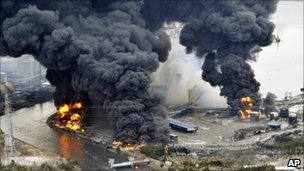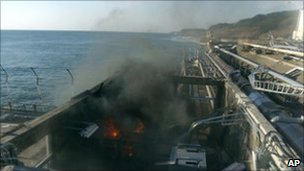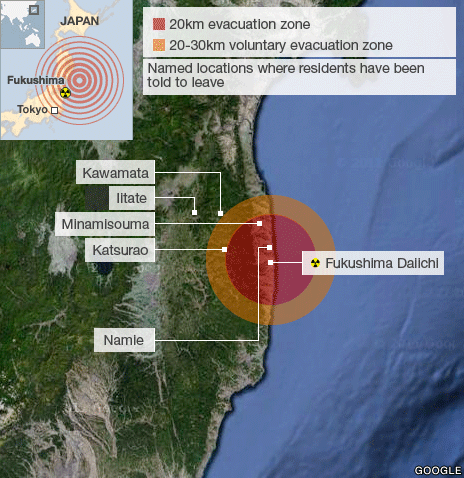11 April 2011 Last updated at 23:46 ET
Japan: Nuclear crisis level raised to highest level
Japanese authorities have raised the measure of severity of their nuclear crisis to the highest level, officials say.
The decision was taken due to radiation measured at the damaged Fukushima Daiichi power plant, NHK reported.
The highest level for nuclear accidents (seven) had previously only applied to the Chernobyl disaster in 1986.
Meanwhile a 6.3-magnitude earthquake was reported off eastern Japan, the second tremor in as many days.
The aftershocks come a month after a huge quake and tsunami hit Japan, leaving nearly 28,000 dead or missing.
Impact of leaks
An official from the Nuclear Safety Commission of Japan announced that the crisis level at the Fukushima Daiichi plant was being raised in a televised statement, adding that it was a preliminary assessment that was subject to confirmation by the International Atomic Energy Agency (IAEA).
The level seven signifies a "major accident" with "wider consequences" than the previous level, officials say.
"We have upgraded the severity level to seven as the impact of radiation leaks has been widespread from the air, vegetables, tap water and the ocean," said Minoru Oogoda of Japan's Nuclear and Industrial Safety Agency (Nisa), the government's nuclear watchdog.
One official from the Tokyo Electric Power Co (Tepco), which operates the nuclear plant, said that radiation leaks had not stopped completely and could eventually exceed those at Chernobyl, Reuters news agency reported.
However, a nuclear safety agency spokesman told reporters the leaks were still small compared to those at the plant in Ukraine, then part of the Soviet Union.
"In terms of volume of radioactive materials released, our estimate shows it is about 10% of what was released by Chernobyl," he said.
The decision to raise the threat level was made after radiation of 10,000 terabequerels per hour had been estimated at the stricken plant for several hours.
That would classify the crisis at level seven on the International Nuclear and Radiological Event Scale (Ines).
It was not clear when that level had been reached. The level has subsequently dropped to less than one terabequerel an hour, reports said.
Evacuations extended
The severity level of Japan's nuclear crisis has so far been set at five, the same as that of the accident at Three Mile Island in the US in 1979.
Japan has also said it is extending the evacuation zone around the crippled nuclear plant because of radiation concerns.
The zone will be widened to encompass five communities beyond the existing 20-km (12-mile) radius, following new data about accumulated radiation levels, officials said.
Japan's nuclear commission said that according to preliminary results, the cumulative level of external radiation exceeded the yearly limit of 1 millisieverts in areas extending more than 60 kms (36 miles) to the north-west of the plant and about 40 km to the south-southwest.
On Monday, a 7.1-magnitude quake hit north-east Japan, leaving three people dead. It also triggered a brief tsunami warning, and forced workers to evacuate the Fukushima Daiichi plant.
Tuesday's quake rocked buildings in the capital, Tokyo.
There were no immediate reports of fresh damage, though Japan's Narita international airport temporarily closed its runways, and metro and train services were interrupted.
The cooling systems at the Fukushima Daiichi nuclear plant were damaged in last month's disaster and workers have been struggling to prevent several reactors from overheating.
Officials have warned it will be several months before the situation at the nuclear facility is brought fully under control.
Tepco said on Tuesday that a fire had broken out briefly at Reactor 4, before being extinguished.
The official death toll from the disaster is 13,130, while 13,718 remain unaccounted for. More than 150,000 people have been made homeless.
Source;
http://www.bbc.co.uk/news/world-asia-pacific-13045341















